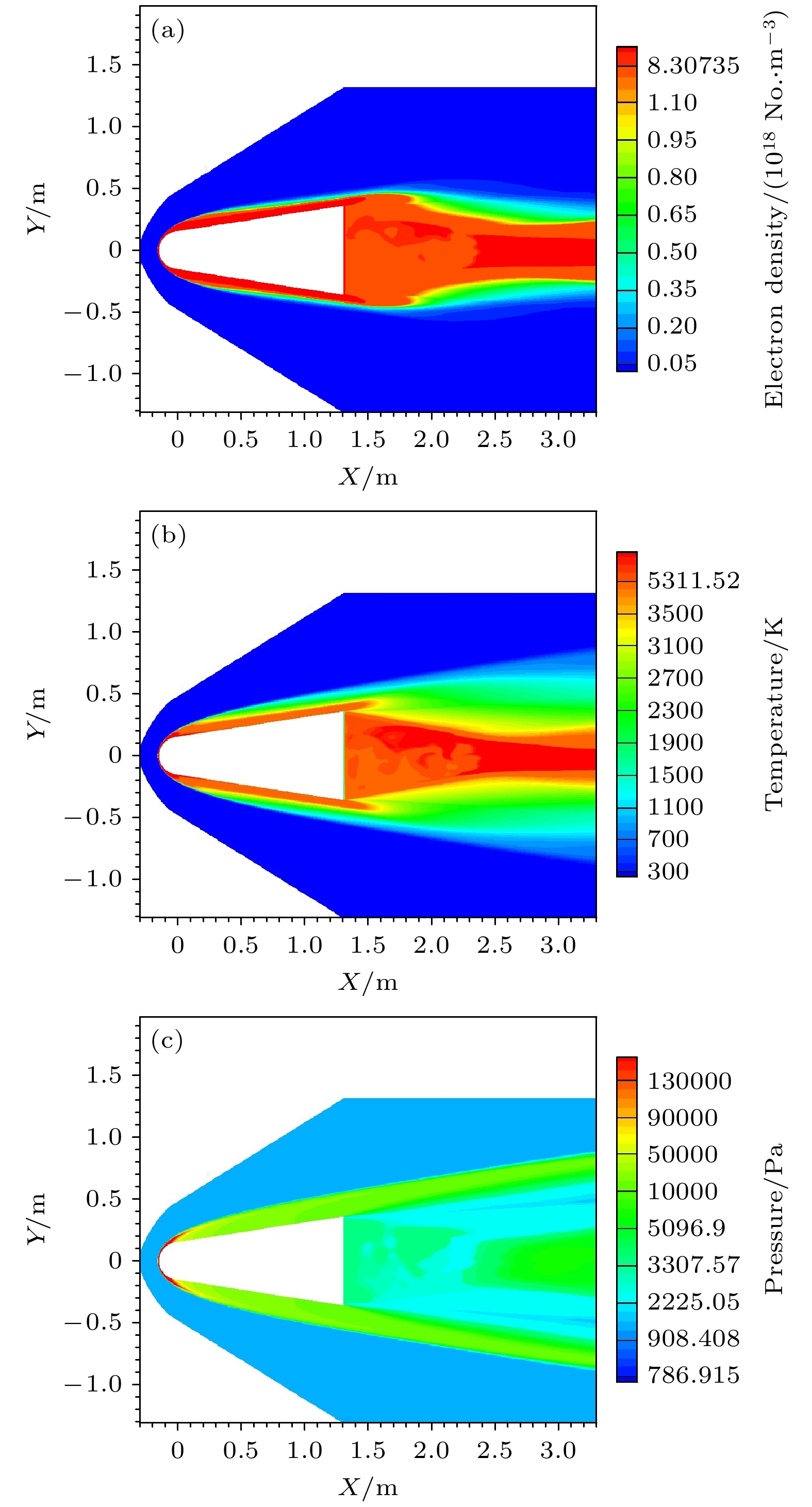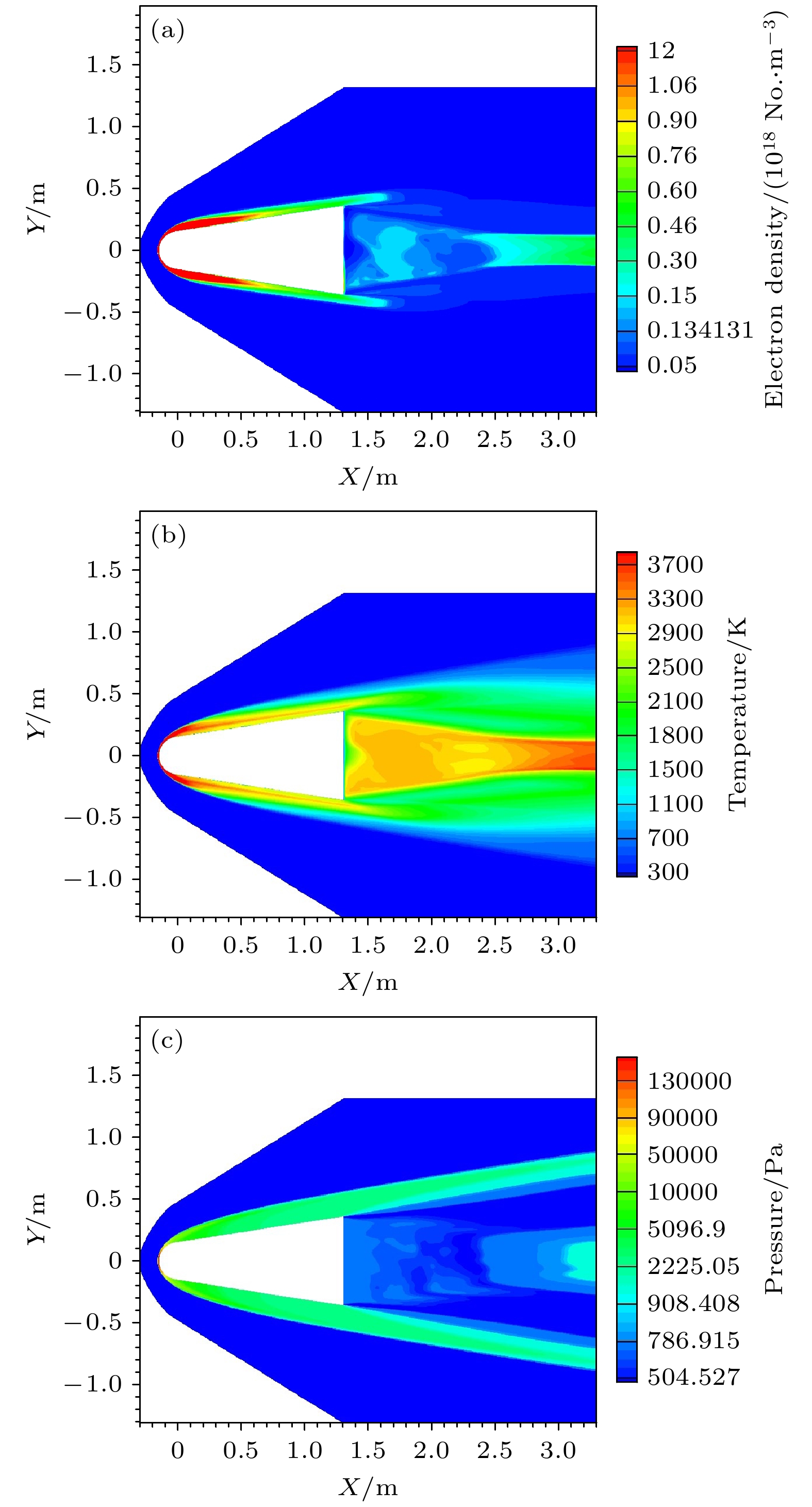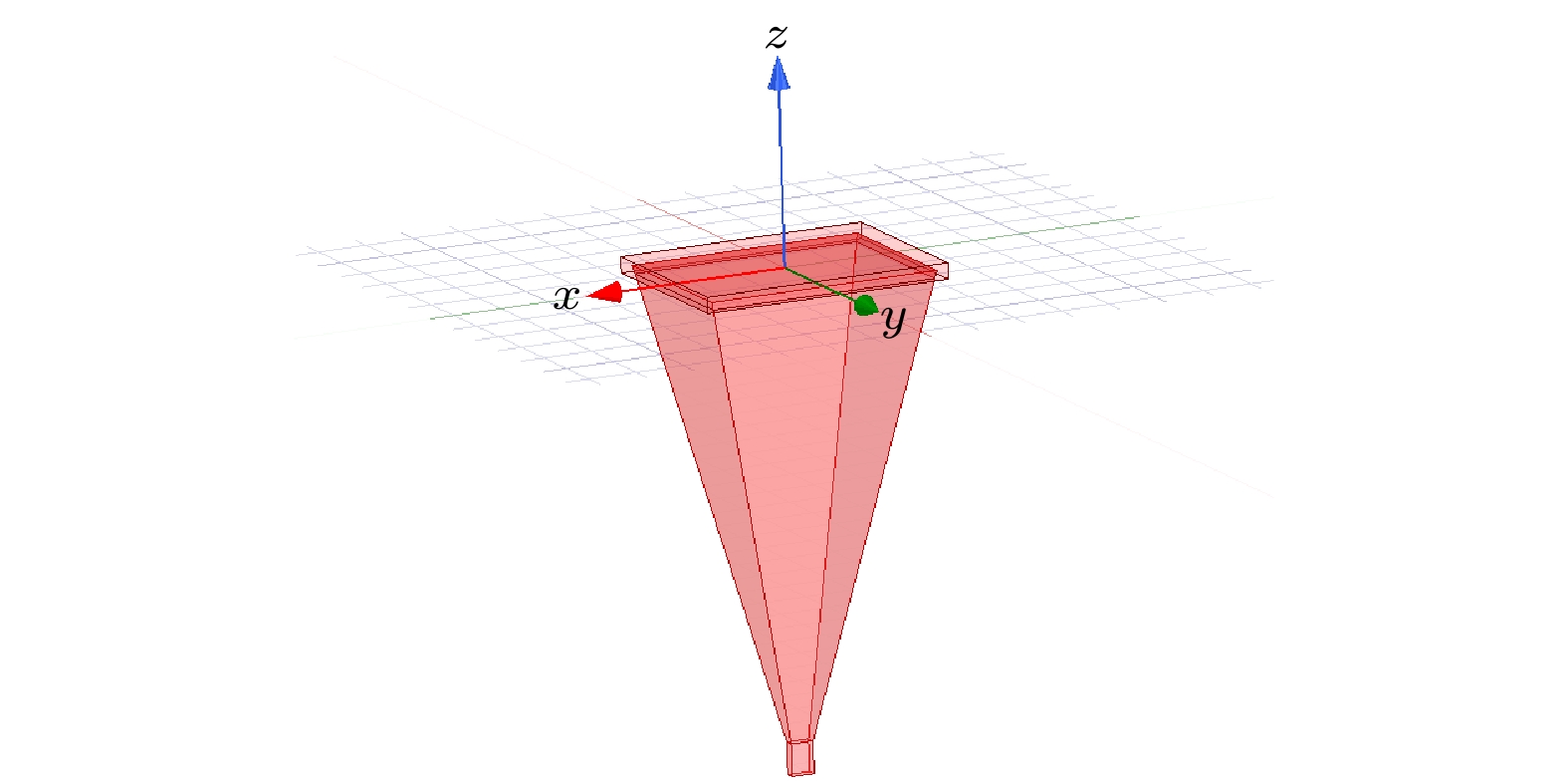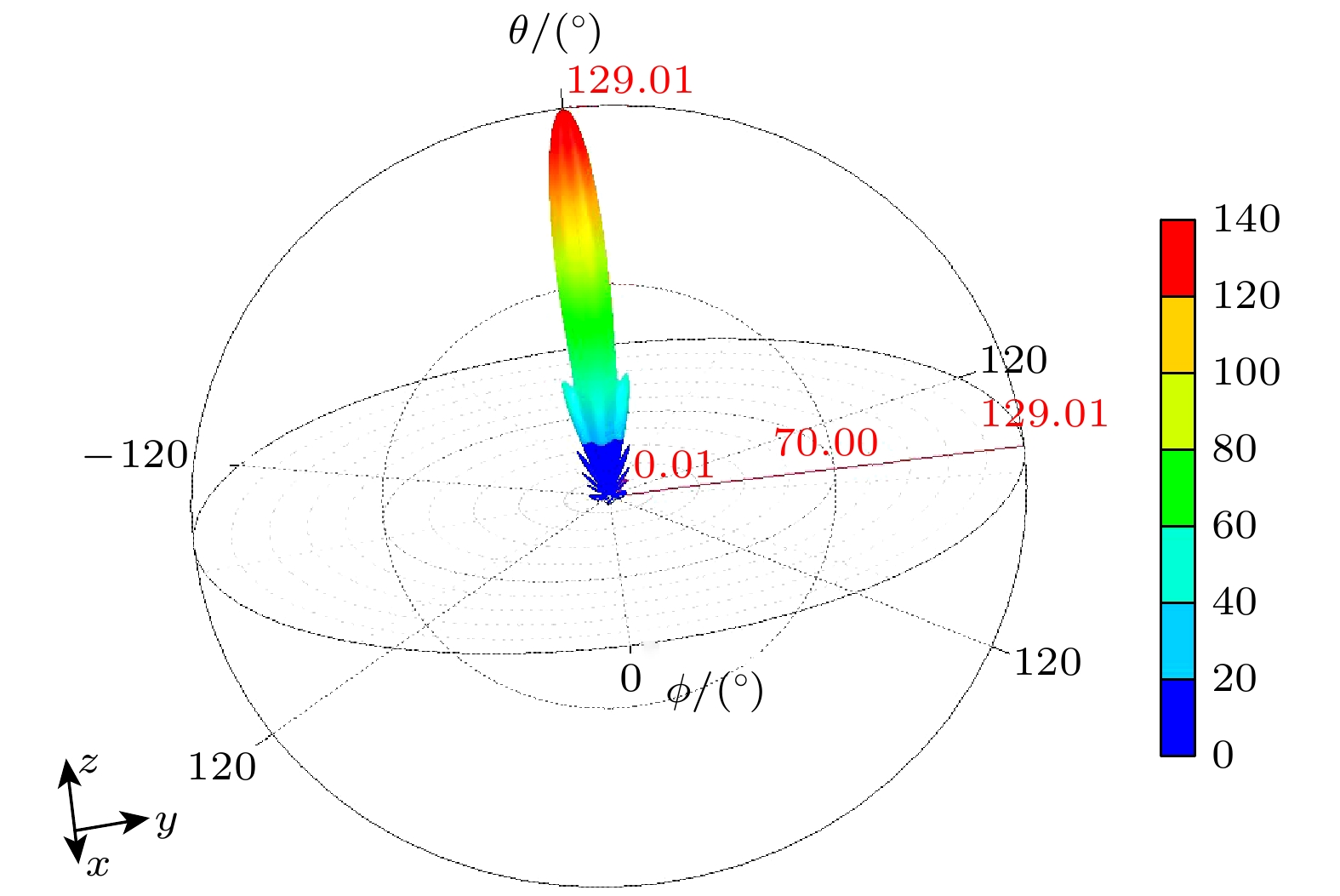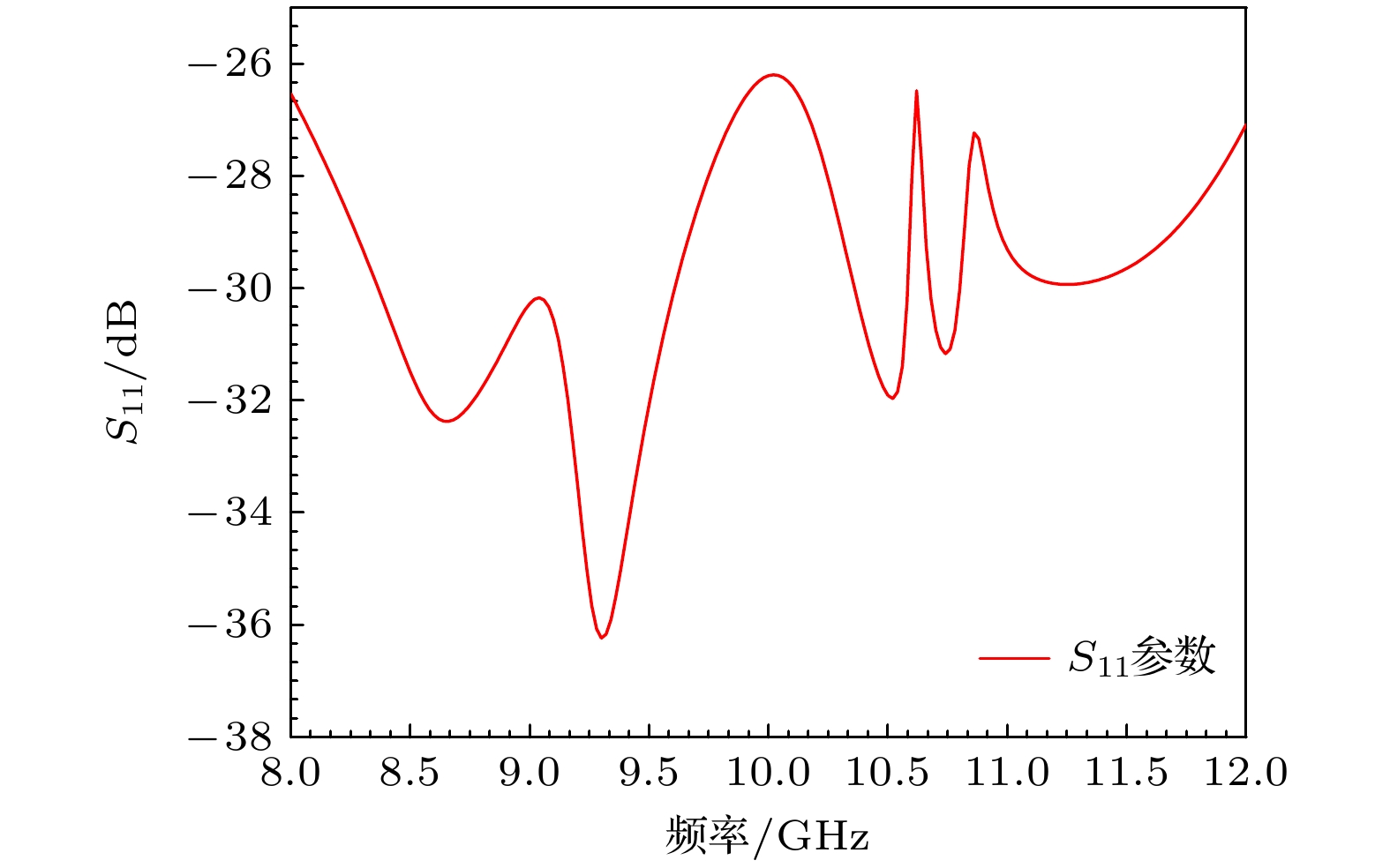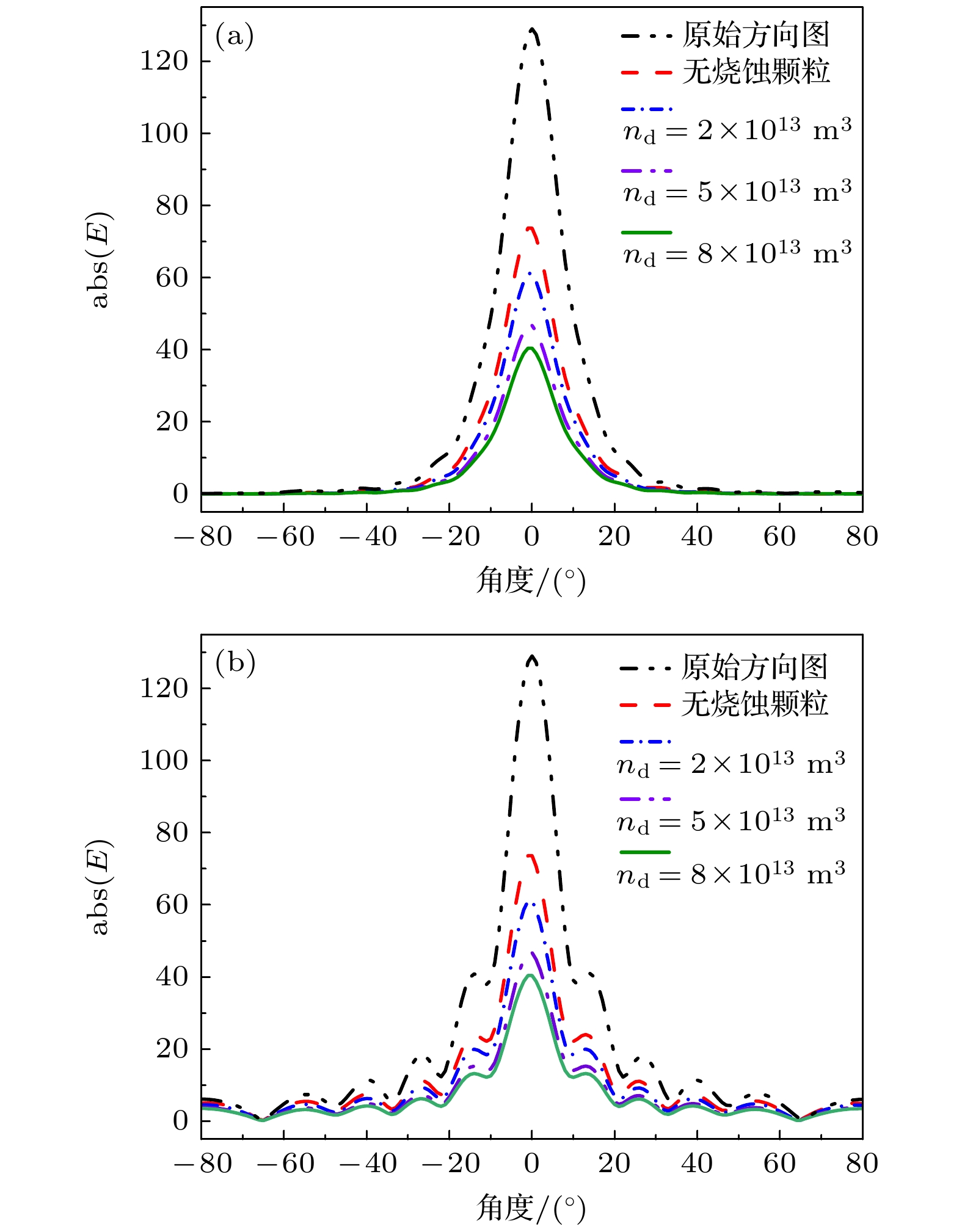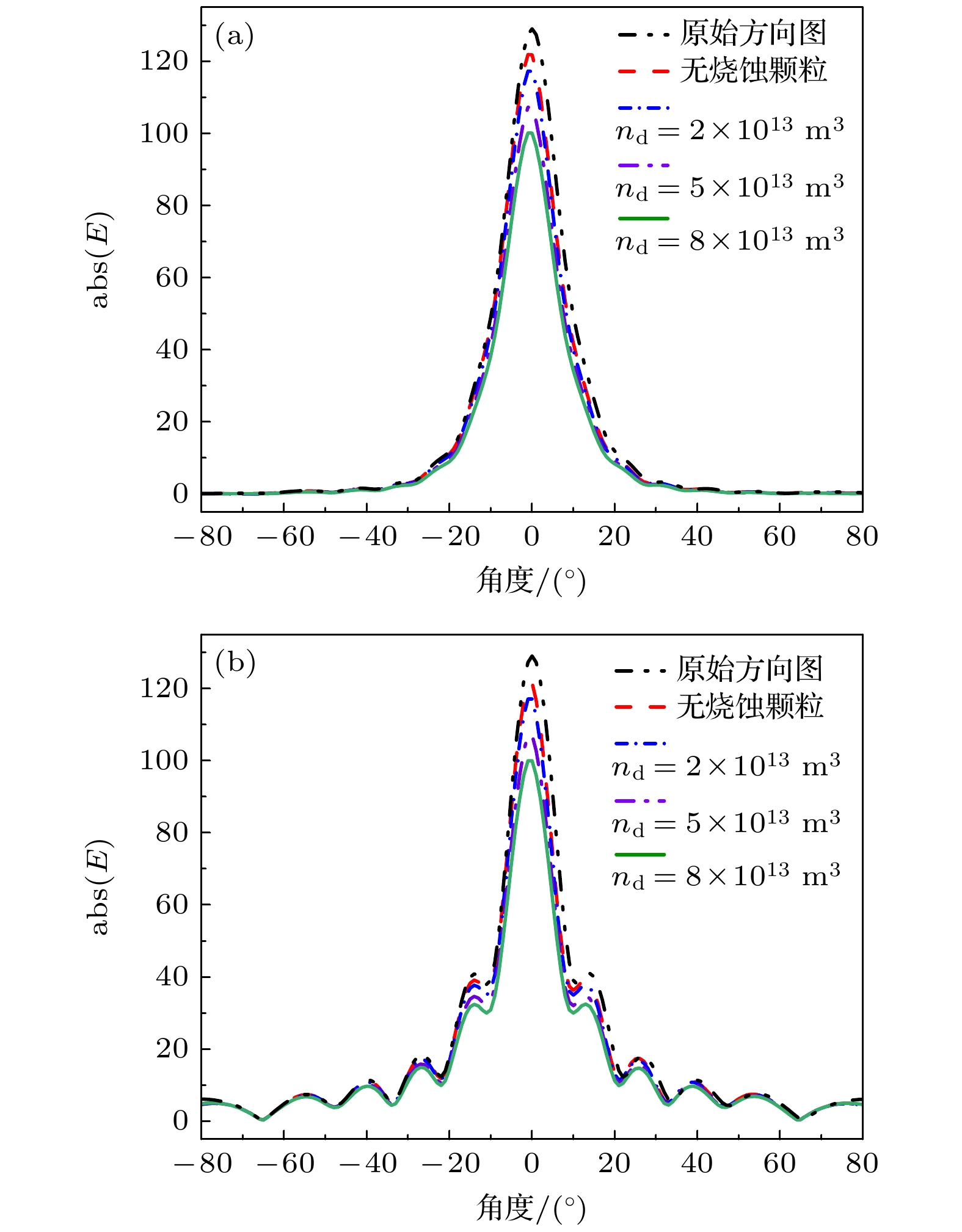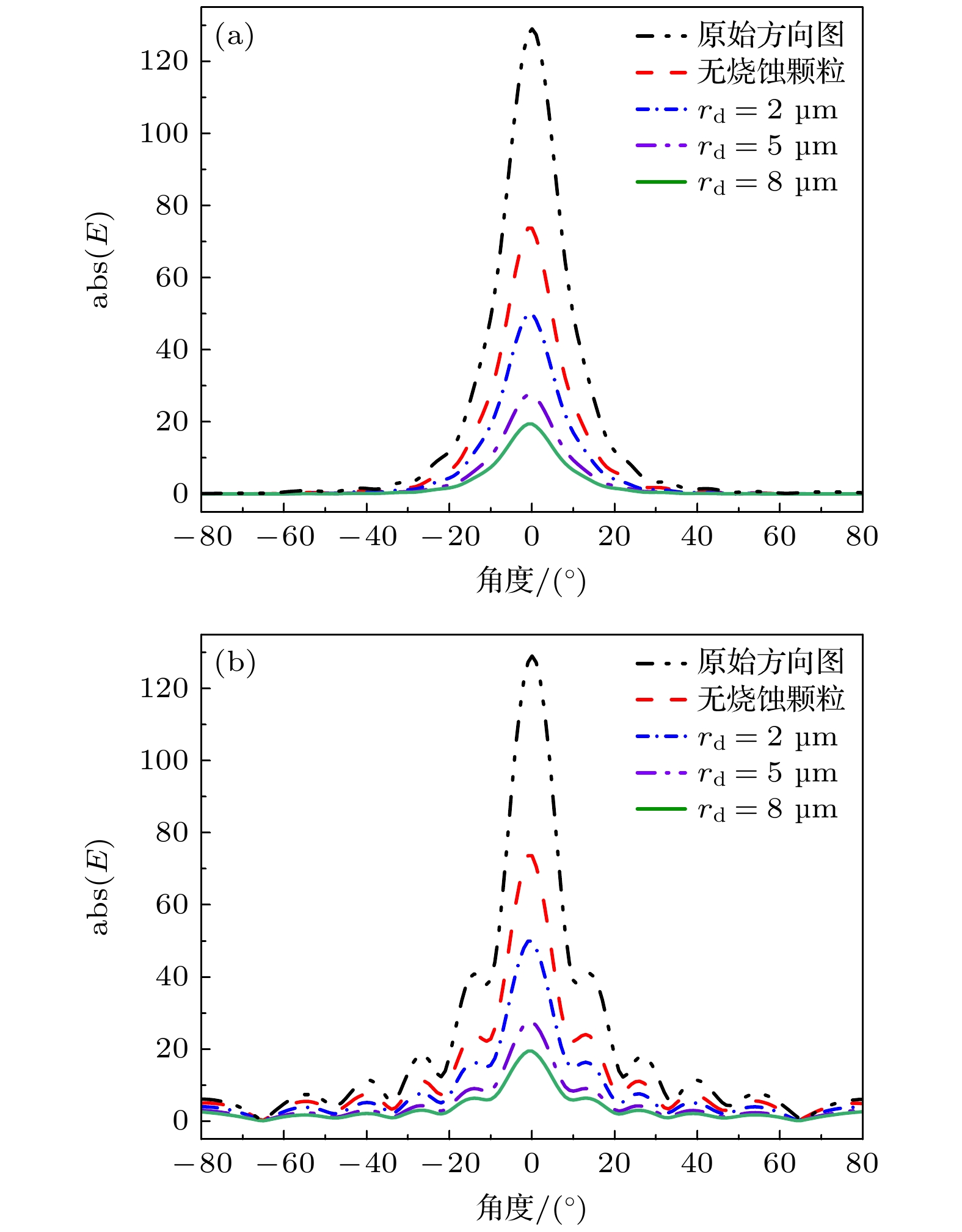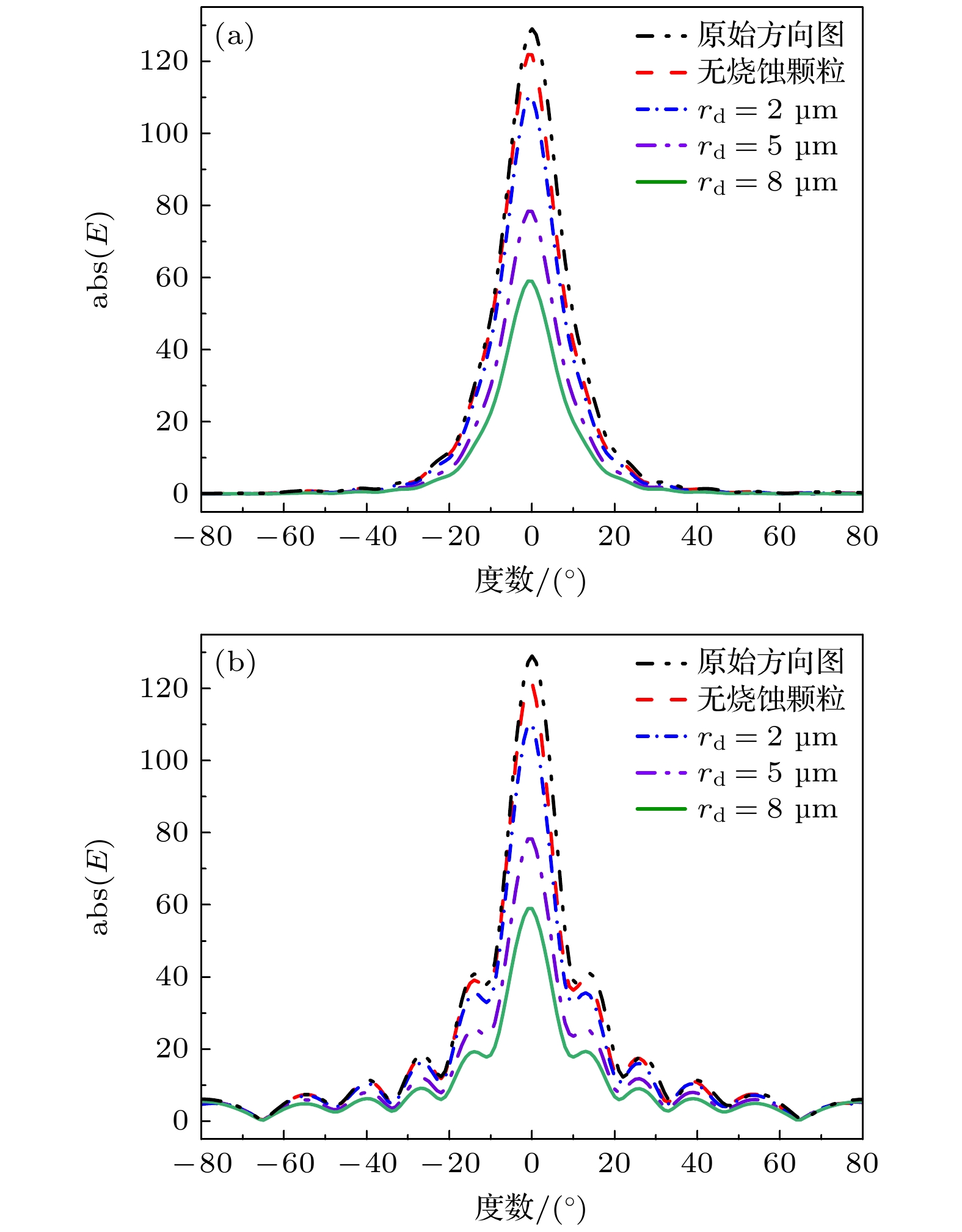-
When the wall temperature of the thermal protection or insulation materials on the surface of an aircraft exceeds their tolerance limits under the heating of supersonic aerodynamic heat energy, degradation damage phenomena such as high-temperature thermochemical ablation and mechanical erosion will occur in the surface area. The ablation diffusion products (ablation particles) generated are ejected into the surrounding plasma flow field and suspended around the aircraft, forming a hypersonic plasma flow field with ablation diffusion substances. The presence of ablation diffusion substances can significantly affect the physical and electromagnetic characteristics of the original plasma flow field. To solve this problem, this study establishes a coupled electromagnetic model of an ablative plasma flow field surrounding a blunt-nosed cone aircraft and analyzes the antenna radiation characteristics in the wake region of the ablative flow field. The research method consists of several key steps. Firstly, the plasma flow field around the blunt-nosed cone is simulated using ANSYS FLUENT, a computational fluid dynamics (CFD) software. This step provides the fundamental flow field parameters such as electron density, temperature, and pressure distributions. Secondly, ablation particles, generated from thermal protection material degradation, are uniformly dispersed into the plasma flow. Then, the ablative plasma flow field is obtained. Thirdly, an X-band horn antenna is designed in ANSYS HFSS and loaded into the center of the wake region of the ablative plasma flow field. Based on the above models, the ray-tracing method is employed to quantitatively evaluate the attenuation of antenna radiation as it propagates through the wake region. The numerical results demonstrate that the plasma flow field enveloping the aircraft induces significant attenuation of antenna radiation energy. It is more noteworthy that the presence of ablation particles within the flow field substantially amplifies this energy dissipation effect. Both the ablation particle density and size distribution are identified as dominant factors controlling radiative energy loss, exhibiting proportional relationships with the attenuation of the incident field. This study systematically proves the influences of ablation particle density and size on initial field energy attenuation. This research can provide a reference for solving the problem of electromagnetic wave propagation that causes the information transmission bottleneck of near-space hypersonic aircraft. It can also serves as a theoretical basis for further in-depth research on technologies such as target detection, identification, thermal protection/insulation materials, and system design of hypersonic aircraft.
-
Keywords:
- supersonic /
- ablation /
- plasma flow /
- antenna radiation characteristics
[1] Korotkevich A O, Newell A C, Zakharov V E 2007 J. Appl. Phys. 102 083305
 Google Scholar
Google Scholar
[2] Li J F, Wang Y, Zhou Z X, Yao J F, Liu J L, Lan Z H, Yuan C X 2023 Nanophotonics 12 1847
 Google Scholar
Google Scholar
[3] Chen S G, Hou L, Shi W, et al. 2023 IEEE Trans. THz Sci. Technol. 13 28
 Google Scholar
Google Scholar
[4] Yang W O, Liu Q, Mao W, Gao S, Wu Z 2023 IEEE Trans. Antennas Propag. 71 2710
 Google Scholar
Google Scholar
[5] Zhang Y, Xu G, Zheng Z 2021 Waves Random Complex Media 31 2466
 Google Scholar
Google Scholar
[6] Bogatskaya A V, Klenov N V, Tereshonok M V, Adjemov, S S, Popov, A M 2018 J. Phys. D: Appl. Phys. 51 185602
 Google Scholar
Google Scholar
[7] 李小平, 刘彦明, 谢楷 2018 高速飞行器等离子体鞘套电磁波传播理论与通信技术(北京: 科学出版社) 第35页
Li X P, Liu Y M, Xie K 2018 Theory and Communication Technology of Electromagnetic Wave Propagation in Plasma Sheath of High Speed Aircraft (Beijing: Science Press) p35
[8] Sha Y X, Zhang H L, Guo X Y, Xia M Y 2019 IEEE Trans. Antennas Propag. 67 2470
 Google Scholar
Google Scholar
[9] Li J, He M, Li X P, Zhang C F 2018 IEEE Trans. Antennas Propag. 66 3653
 Google Scholar
Google Scholar
[10] Zhao Z Y, Yuan K, Tang R X, Lin H, Deng X H 2022 IEEE Trans. Plasma Sci. 50 517
 Google Scholar
Google Scholar
[11] Ni Y X, Zhao Z Y, Yuan K, Tang Y X, Hong L J 2023 IEEE Trans. Plasma Sci. 51 2736
 Google Scholar
Google Scholar
[12] Mei J, Xie Y J 2017 IEEE Trans. Plasma Sci. 45 364
 Google Scholar
Google Scholar
[13] Xu J, Bai B W, Dong C X, Zhu Y T, Dong Y Y, Zhao G Q 2017 IEEE Antennas Wireless Propag. Lett. 16 1056
 Google Scholar
Google Scholar
[14] Chen X Y, Li K X, Liu Y Y, Zhou Y G, Li X P, Liu Y M 2017 IEEE Trans. Plasma Sci. 45 3166
 Google Scholar
Google Scholar
[15] 郑永康, 叶友达, 田浩, 田浩, 蒋勤学 2024 空天技术 458 54
Zheng Y K, Ye Y D, Tian H, Tian H, Jiang Q X 2024 Aerosp. Technol. 458 54
[16] Mao M Y, Peng K P, Zhao Z Y, Yuan K, Xiong J W, Tang R X, Deng X H 2024 IEEE Trans. Plasma Sci. 52 240
 Google Scholar
Google Scholar
[17] Deng Q Q, Chen W, Yang L X, Chen C X, Bo Y, Guo L X 2024 IEEE Trans. Plasma Sci. 52 1452
 Google Scholar
Google Scholar
[18] Guo Y J, Shi W B, Zeng L, Du B H 2019 Mechanism of Ablative Thermal Protection Applied To Hypersonic Vehicles p25 ((in Chinese)[国义军, 石卫波, 曾磊, 杜百合 2019 高超声速飞行器烧蚀防热理论与应用(北京: 科学出版社) 第25页]
[19] Bisek N J, Poggie J 2011 42th AIAA Plasmadynamics and Lasers Conference Hawii, USA, June 27–30, 2011, AIAA 2011-897
[20] 曾学军, 李海燕 2017 宇航学报 38 109
Zeng X J, Li H Y 2017 J. Astronaut. 38 109
[21] 李开 2017 博士学位论文 (长沙: 国防科学技术大学)
Li K 2017 Ph. D. Dissertation (Changsha: National University of Defense Technology
[22] 李开, 刘伟强 2016 65 064701
 Google Scholar
Google Scholar
Li K, Liu W Q 2016 Acta Phys. Sin. 65 064701
 Google Scholar
Google Scholar
[23] 姚霄, 刘伟强, 谭建国 2018 67 174702
 Google Scholar
Google Scholar
Yao X, Liu W Q, Tan J G 2018 Acta Phys. Sin. 67 174702
 Google Scholar
Google Scholar
[24] Robin A M, Adam S P, Partho P 2019 J. Thermophys. Heat TR 33 1018
 Google Scholar
Google Scholar
[25] 丁明松, 刘庆宗, 江涛, 傅杨奥骁, 李鹏, 梅杰 2024 73 115204
 Google Scholar
Google Scholar
Ding M S, Liu Q Z, Jiang T, Fu Y A X, Li P, Mei J 2024 Acta Phys. Sin. 73 115204
 Google Scholar
Google Scholar
[26] Shao C, Nie L, Chen W F 2016 Aerosp. Sci. Technol. 51 151
 Google Scholar
Google Scholar
[27] 赵文文 2014 博士学位论文(杭州: 浙江大学)
Zhao W W 2014 Ph. D. Dissertation (Hangzhou: Zhejiang University
[28] Chang P C Y, Walker J G, Hopcraft K I 2005 J. Quant. Spectrosc. Radiat. Transfer 96 327
 Google Scholar
Google Scholar
[29] Li L Q, Wei B, Yang Q, Yang X, Ge D B 2017 IEEE Trans. Antennas wireless propag. Letter. 16 2078
 Google Scholar
Google Scholar
[30] Wang M Y, Li H L, Dong Y L, Li G P, Jiang B J, Zhao Q, Xu J 2016 IEEE Trans. Antennas Propag. 64 286
 Google Scholar
Google Scholar
-
表 1 X波段喇叭天线结构参数
Table 1. Structural parameters of X-band horn antenna.
波导
宽度
W/mm波导
高度
H/mm波导
长度
/mm喇叭口
径宽度
W1/mm喇叭口
径高度
H1/mm喇叭
长度
/mm23 10 32 238 176 465 -
[1] Korotkevich A O, Newell A C, Zakharov V E 2007 J. Appl. Phys. 102 083305
 Google Scholar
Google Scholar
[2] Li J F, Wang Y, Zhou Z X, Yao J F, Liu J L, Lan Z H, Yuan C X 2023 Nanophotonics 12 1847
 Google Scholar
Google Scholar
[3] Chen S G, Hou L, Shi W, et al. 2023 IEEE Trans. THz Sci. Technol. 13 28
 Google Scholar
Google Scholar
[4] Yang W O, Liu Q, Mao W, Gao S, Wu Z 2023 IEEE Trans. Antennas Propag. 71 2710
 Google Scholar
Google Scholar
[5] Zhang Y, Xu G, Zheng Z 2021 Waves Random Complex Media 31 2466
 Google Scholar
Google Scholar
[6] Bogatskaya A V, Klenov N V, Tereshonok M V, Adjemov, S S, Popov, A M 2018 J. Phys. D: Appl. Phys. 51 185602
 Google Scholar
Google Scholar
[7] 李小平, 刘彦明, 谢楷 2018 高速飞行器等离子体鞘套电磁波传播理论与通信技术(北京: 科学出版社) 第35页
Li X P, Liu Y M, Xie K 2018 Theory and Communication Technology of Electromagnetic Wave Propagation in Plasma Sheath of High Speed Aircraft (Beijing: Science Press) p35
[8] Sha Y X, Zhang H L, Guo X Y, Xia M Y 2019 IEEE Trans. Antennas Propag. 67 2470
 Google Scholar
Google Scholar
[9] Li J, He M, Li X P, Zhang C F 2018 IEEE Trans. Antennas Propag. 66 3653
 Google Scholar
Google Scholar
[10] Zhao Z Y, Yuan K, Tang R X, Lin H, Deng X H 2022 IEEE Trans. Plasma Sci. 50 517
 Google Scholar
Google Scholar
[11] Ni Y X, Zhao Z Y, Yuan K, Tang Y X, Hong L J 2023 IEEE Trans. Plasma Sci. 51 2736
 Google Scholar
Google Scholar
[12] Mei J, Xie Y J 2017 IEEE Trans. Plasma Sci. 45 364
 Google Scholar
Google Scholar
[13] Xu J, Bai B W, Dong C X, Zhu Y T, Dong Y Y, Zhao G Q 2017 IEEE Antennas Wireless Propag. Lett. 16 1056
 Google Scholar
Google Scholar
[14] Chen X Y, Li K X, Liu Y Y, Zhou Y G, Li X P, Liu Y M 2017 IEEE Trans. Plasma Sci. 45 3166
 Google Scholar
Google Scholar
[15] 郑永康, 叶友达, 田浩, 田浩, 蒋勤学 2024 空天技术 458 54
Zheng Y K, Ye Y D, Tian H, Tian H, Jiang Q X 2024 Aerosp. Technol. 458 54
[16] Mao M Y, Peng K P, Zhao Z Y, Yuan K, Xiong J W, Tang R X, Deng X H 2024 IEEE Trans. Plasma Sci. 52 240
 Google Scholar
Google Scholar
[17] Deng Q Q, Chen W, Yang L X, Chen C X, Bo Y, Guo L X 2024 IEEE Trans. Plasma Sci. 52 1452
 Google Scholar
Google Scholar
[18] Guo Y J, Shi W B, Zeng L, Du B H 2019 Mechanism of Ablative Thermal Protection Applied To Hypersonic Vehicles p25 ((in Chinese)[国义军, 石卫波, 曾磊, 杜百合 2019 高超声速飞行器烧蚀防热理论与应用(北京: 科学出版社) 第25页]
[19] Bisek N J, Poggie J 2011 42th AIAA Plasmadynamics and Lasers Conference Hawii, USA, June 27–30, 2011, AIAA 2011-897
[20] 曾学军, 李海燕 2017 宇航学报 38 109
Zeng X J, Li H Y 2017 J. Astronaut. 38 109
[21] 李开 2017 博士学位论文 (长沙: 国防科学技术大学)
Li K 2017 Ph. D. Dissertation (Changsha: National University of Defense Technology
[22] 李开, 刘伟强 2016 65 064701
 Google Scholar
Google Scholar
Li K, Liu W Q 2016 Acta Phys. Sin. 65 064701
 Google Scholar
Google Scholar
[23] 姚霄, 刘伟强, 谭建国 2018 67 174702
 Google Scholar
Google Scholar
Yao X, Liu W Q, Tan J G 2018 Acta Phys. Sin. 67 174702
 Google Scholar
Google Scholar
[24] Robin A M, Adam S P, Partho P 2019 J. Thermophys. Heat TR 33 1018
 Google Scholar
Google Scholar
[25] 丁明松, 刘庆宗, 江涛, 傅杨奥骁, 李鹏, 梅杰 2024 73 115204
 Google Scholar
Google Scholar
Ding M S, Liu Q Z, Jiang T, Fu Y A X, Li P, Mei J 2024 Acta Phys. Sin. 73 115204
 Google Scholar
Google Scholar
[26] Shao C, Nie L, Chen W F 2016 Aerosp. Sci. Technol. 51 151
 Google Scholar
Google Scholar
[27] 赵文文 2014 博士学位论文(杭州: 浙江大学)
Zhao W W 2014 Ph. D. Dissertation (Hangzhou: Zhejiang University
[28] Chang P C Y, Walker J G, Hopcraft K I 2005 J. Quant. Spectrosc. Radiat. Transfer 96 327
 Google Scholar
Google Scholar
[29] Li L Q, Wei B, Yang Q, Yang X, Ge D B 2017 IEEE Trans. Antennas wireless propag. Letter. 16 2078
 Google Scholar
Google Scholar
[30] Wang M Y, Li H L, Dong Y L, Li G P, Jiang B J, Zhao Q, Xu J 2016 IEEE Trans. Antennas Propag. 64 286
 Google Scholar
Google Scholar
Catalog
Metrics
- Abstract views: 719
- PDF Downloads: 17
- Cited By: 0
















 DownLoad:
DownLoad:

